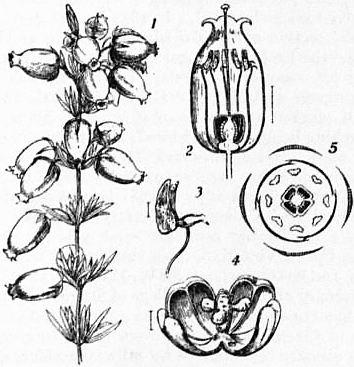1911 Encyclopædia Britannica/Ericaceae
 |
| Fig. 1.—Vaccinium vitis-idaea, with leaf and flower, nat. size. 1, Flower of V. myrtillus, cut lengthwise. 2, Fruit of same. |
ERICACEAE, in botany, a natural order of plants belonging to the higher or gamopetalous division of Dicotyledons. They are woody plants, sometimes with a slender creeping stem as in bilberry, Vaccinium (fig. 1), or Andromeda (fig. 2), or forming low bushes as in the heaths, or larger, sometimes becoming tree-like, as in species of Rhododendron. The leaves are alternate, opposite or whorled in arrangement, and in their form and structure show well-marked adaptation for life in dry or exposed situations. Thus in the true heaths they are needle-like, with the margins often rolled back to form a groove or an almost closed chamber on the under side. In others such as Rhododendron or Arbutus they are often leathery and evergreen, the strongly cuticularized upper surface protecting a water-storing tissue situated above the green layers of the leaf. The flowers are sometimes solitary and axillary or terminal as in Andromeda, but are generally arranged in racemose inflorescences at the end of the branches as in Arbutus and Rhododendron, or on small lateral shoots as in Erica. They are hermaphrodite and generally regular with parts in 4 or 5, thus: sepals 4 or 5, petals 4 or 5, stamens 8 or 10 in two series, the outer of which is opposite the petals, and carpels 4 or 5. The corolla is usually more or less bell-shaped, and in the heaths persists in a dry state in the fruit. The petals with the stamens are situated on the outer edge of a honey-secreting disk. The anthers show a very great variety in shape, the halves are often more or less free and often appendaged; they open to allow the escape of the pollen by a terminal pore or slit. The carpels are united to form a 4- to 5-chambered ovary, which bears a simple elongated style ending in a capitate stigma; each ovary-chamber contains one to many ovules attached to a central placenta. The brightly coloured corolla, the presence of nectar and the scent render the flowers attractive to insects, and the projection of the stigma beyond the anthers favours crossing. The fruit is generally a capsule containing many seeds, as in Erica (fig. 3) or Rhododendron; sometimes a berry as in Arbutus.
 |
| Fig. 2.—Andromeda Hypnoides, nat. size. 1, Flower; 2, Unripe fruit cut across; 3, Stamen—all enlarged. |
The order falls into four distinct tribes, which are characterized by the relative position of the ovary and by the fruit and seed. They are as follows:—
1. Rhododendron tribe, characterized by capsular fruit, seed with a loose coat, deciduous petals and anthers without appendages. It consists mainly of the great genus Rhododendron (in which Azalea is included by recent botanists), which is chiefly developed in the mountains of eastern Asia, many species occurring on the Himalayas. Dabeocia, St Dabeoc’s heath, occurs in Ireland.
2. Arbutus Tribe.—Fruit a berry or capsule, petals deciduous and anthers with bristle-like appendages, chiefly north temperate to arctic in distribution. Arbutus Unedo, the strawberry-tree, so called from its large scarlet berry, is a southern European species which extends into south Ireland. Arctostaphylos (bearberry) and Andromeda are arctic and alpine genera occurring in Britain. Epigaea repens is the trailing arbutus or mayflower of Atlantic America.
3. Vaccinium Tribe.—Ovary inferior, fruit a berry. Extends from the north temperate zone to the mountains of the tropics. Vaccinium, the largest genus, has four British species: V. Myrtillus is the bilberry (q.v.), blaeberry or whortleberry, V. Vitis-Idaea the cowberry, and V. Oxycoccos the cranberry (q.v.). This tribe is sometimes regarded as a separate order Vacciniaceae, distinguished by its inferior ovary.
4. Erica Tribe.—Fruit usually a capsule, seeds round, not winged; corolla persisting round the ripe fruit; anthers often appendaged. The largest genus is Erica, the true heath (q.v.), with over 400 species, the great majority of which are confined to the Cape; others occur on the mountains of tropical Africa and in Europe and North Africa, especially the Mediterranean region. E. cinerea (purple heather) and E. Tetralix (cross-leaved heath) are common British heaths. Calluna is the ling or Scotch heather.

